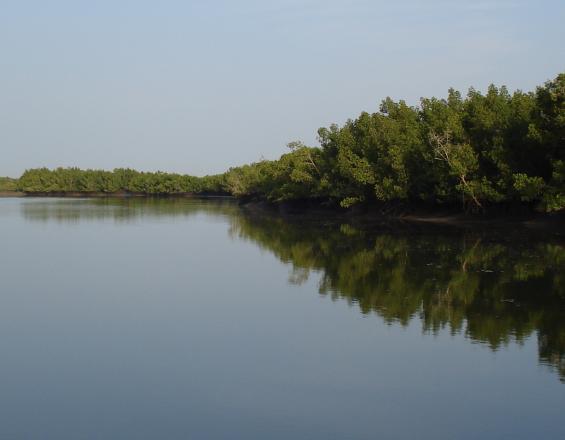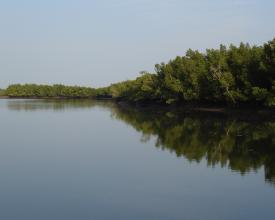
Conservation des mangroves, changement climatique et sécurité alimentaire
Solution complète

Mangroves à Rio Cacheu
Pierre Campredon
L'élévation du niveau de la mer rend nécessaire le rehaussement des digues des rizières. Cependant, les populations indigènes de Guinée-Bissau manquent d'emplois et ont tendance à quitter les rizières. L'initiative se concentre sur la restauration des rizières et des mangroves qui ont été abandonnées. Un ensemble d'activités alternatives (pêche, tourisme) et de mesures de conservation complètent ce modèle de gouvernance partagée.
Dernière modification 30 Sep 2020
6224 Vues
Contexte
Défis à relever
Dégradation des mangroves due à la riziculture, aux conflits entre l'homme et la faune, à la perte de connaissances
Emplacement
Guinée Bissau
Afrique occidentale et centrale
Traiter
Blocs de construction
Processus de gouvernance partagée
Avec la transformation des systèmes de gestion traditionnels et des échelles d'intervention des acteurs, de nouvelles règles sont définies en matière d'accès et d'utilisation des ressources naturelles. Toutes les parties prenantes sont impliquées dans un processus de gouvernance partagée. Le processus itératif a été mis en œuvre successivement au niveau du village, puis au niveau de tous les acteurs, à chaque étape : information, consultation, négociation, mise en œuvre. L'ensemble du processus s'est déroulé sur une période de quatre ans, mais l'expérience montre que la facilitation est toujours nécessaire à long terme. L'UICN a joué un rôle de facilitateur dans le processus et s'est efforcée de rester neutre tout en fournissant des conseils techniques et méthodologiques.
Facteurs favorables
Une bonne connaissance des techniques de gouvernance partagée ; une compréhension des contextes socio-économiques, culturels et environnementaux, et des sources potentielles de conflit ; de la flexibilité et du temps pour concilier les points de vue et les intérêts des différentes parties prenantes ; des actions tangibles de soutien aux parties prenantes qui répondent à leurs besoins réels et pratiques ; des actions de communication et d'éducation ; de la formation.
Leçon apprise
Pour commencer, il est essentiel de prendre en compte les préoccupations tangibles et immédiates des groupes de population concernés. Ce n'est qu'ensuite que l'on pourra les engager progressivement dans le dialogue, la consultation et la négociation. Il est nécessaire de disposer d'informations précises et actualisées sur la situation de l'environnement, des ressources et des aspects socio-économiques des parties prenantes concernées. Une structure de coordination reconnue et objective est nécessaire pour une consultation équilibrée des parties prenantes. Prenez le temps nécessaire pour concilier les points de vue des différentes parties prenantes. Ne pas précipiter le processus afin de pouvoir respecter les engagements pris envers les bailleurs de fonds.
Renforcement des capacités techniques
Chaque acteur du Parc de Cacheu a vu ses capacités renforcées. Le Centre de recherche océanographique pour l'étude des ressources a reçu des formations et des outils supplémentaires pour réaliser l'évaluation des ressources halieutiques et proposer des règles de gestion. Le personnel de l'IBAP a été formé à l'imagerie aérienne et aux mécanismes de gouvernance partagée. Des formations et des moyens (bateaux de surveillance) ont été consacrés à la mise en œuvre de la surveillance maritime et du suivi de la biodiversité. Les institutions d'éducation et de communication formelles et informelles ont vu leurs capacités renforcées et des outils pédagogiques leur ont été fournis.
Facteurs favorables
Renforcer systématiquement les capacités locales en vue d'une autonomisation progressive des parties prenantes, en gardant à l'esprit que les projets et les financements sont temporaires.
Leçon apprise
L'autonomisation des parties prenantes peut rendre le processus cohérent avec les réalités culturelles des parties prenantes. Le processus devrait progressivement devenir aussi endogène que possible, d'où la nécessité de renforcer les capacités locales. Une grande partie de l'apprentissage peut et doit être basée sur les connaissances locales. Les pêcheurs et les agriculteurs disposent d'un corpus de connaissances considérable, directement adapté à leur terre et à leur pays. En nous appuyant sur leurs connaissances, nous améliorons leur adhésion générale, la cohérence des interventions et la durabilité du processus.
Structure de coordination des parties prenantes
Une structure de supervision a été mise en place pour faciliter la coordination entre les parties prenantes et la cohérence globale du processus. Ses membres travaillent en coopération et unissent leurs forces, chacun apportant sa propre spécialisation. Une organisation internationale (en l'occurrence, l'UICN) a soutenu cette initiative en préparant les documents de projet, en recherchant des financements auprès des donateurs et en fournissant un soutien technique et administratif. Grâce à la présence de membres gouvernementaux et non gouvernementaux côte à côte, il est possible d'influencer les politiques de conservation des mangroves et de la pêche artisanale.
Facteurs favorables
Une structure de coordination et de dialogue permet de créer une coalition cohérente autour d'un programme commun. Cette coalition définit des priorités d'intervention et des objectifs communs. En collaborant, leur travail va dans le même sens et renforce l'influence de leurs actions et de leur plaidoyer.
Leçon apprise
Lorsque l'on travaille à des objectifs communs, il est nécessaire de laisser une grande flexibilité aux méthodes d'intervention des partenaires afin qu'ils puissent exprimer leur propre vision. La qualité de la participation et de l'adhésion des acteurs au programme dépend largement de la qualité et de la quantité des ressources fournies par l'agence de coordination. Les organisations internationales de conservation ne doivent pas chercher à s'approprier les projets mais plutôt à les développer au profit des agences nationales.
Éducation et communication
Des ressources, des outils et des formations spécifiques ont été fournis aux structures formelles et informelles d'éducation et de communication. Une radio locale a été créée pour soutenir et alimenter la dynamique d'information et de consultation, et tous les médias possibles ont été largement utilisés, notamment à travers le soutien à plusieurs autres radios et chaînes de télévision communautaires, et la diffusion de documentation. Un film a été réalisé avec une équipe locale sur le processus. Ce fut l'occasion de proposer une formation à la prise de vue et au montage. Le film a été diffusé à plusieurs reprises sur la télévision nationale et est utilisé comme outil de facilitation dans les villages. Un travail d'éducation à l'environnement a été mené avec toutes les écoles par le biais de la formation des enseignants, de la création de matériel pédagogique, de camps de jeunes, de petits projets à mettre en œuvre dans les écoles (plantations, jardins, surveillance météorologique). Le parc sert désormais de terrain de formation pour les équipes pédagogiques nationales dans le domaine du changement climatique.
Facteurs favorables
Existence de radios communautaires ; Formation technique pour familiariser les participants avec les enjeux du changement climatique ; Outils pédagogiques adaptés au contexte.
Leçon apprise
Les modules d'information et d'éducation doivent être adaptés au contexte culturel et environnemental des cibles concernées. Les gens ont une bonne connaissance de leur environnement et de la biodiversité, mais ne sont pas conscients des impacts potentiels du changement climatique. L'éducation à l'environnement devrait donc se concentrer sur ces questions globales plutôt que sur la connaissance de l'environnement.
Aménagement du territoire participatif
Pour identifier les zones prioritaires d'intervention pour la récupération des rizières et la restauration de la mangrove, il a été nécessaire de s'appuyer sur la connaissance intime qu'ont les populations de leur environnement et de l'histoire de son évolution en relation avec le changement climatique. Le principal outil de travail a été la photographie en kit, qui a permis d'obtenir une vue d'ensemble des composantes du territoire, servant de base à la définition des priorités d'aménagement du territoire. Il s'agit d'une technique rentable qui peut être facilement mise en œuvre au niveau local et qui permet un niveau élevé de participation des parties prenantes.
Facteurs favorables
Une technologie facile à mettre en œuvre et rentable ; Des photos imprimées et agrandies, pour faciliter le dialogue ; Sensibiliser aux impacts du changement climatique.
Leçon apprise
Les personnes qui manipulent l'outil doivent être accompagnées par des animateurs qui ont une bonne connaissance des techniques d'animation et des enjeux liés aux options de gestion du territoire. La plupart du temps, ce sont les habitants eux-mêmes qui apportent les éléments de lecture du paysage et de son évolution, mais ils sont souvent conscients des changements à venir.
Impacts
Une approche participative de l'aménagement du territoire impliquant la population locale a permis d'identifier les zones de rizières à maintenir, ainsi que les zones anciennement cultivées qui sont maintenant dédiées à la restauration des mangroves. Certaines zones de rizières menacées par l'élévation du niveau de la mer ont été récupérées grâce à l'élévation des digues. En contrepartie, une partie de la mangrove a été récupérée avec l'aide de la population, ce qui a eu des impacts sur les ressources halieutiques et la biodiversité. L'approche de gouvernance partagée a été étendue à d'autres aspects de la gestion de l'aire protégée et du développement communautaire (pêche, tourisme, conservation, éducation, suivi). Cette approche pionnière a été reproduite dans d'autres zones protégées du pays.
Bénéficiaires
Communautés locales, ministère de la pêche, ministère de l'éducation, opérateurs touristiques, ONG nationales.
